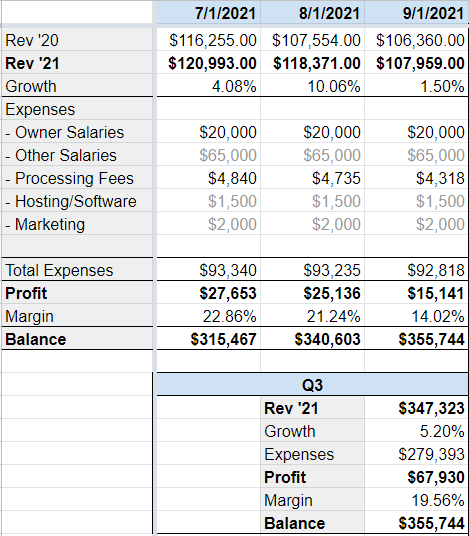Here's a thread about how we do profit sharing bonuses for @pmproplugin, a company of about 15 people.
Lots of inspiration from @wilreynolds and @Shpigford on this and generally how to treat employees well.
Some lessons learned through the years. 👇🧵
First, why give bonuses vs straight pay increase?
We try to pay good base salaries as well, but on top of that, we give bonuses (a) to share the success and profit of the company and (b) to encourage employees to work toward that success and profit.
We don't give raises as a reward for a job well done. Raises are given to account for inflation and to compensate our employees properly based on the job they are doing and how they've been growing in their roles.
The bonuses we give are one time payments. If next year isn't as good as this year, we can pay a smaller bonus or even skip it.
Employees might be disappointed, but it's much worse to have to lower salaries or let folks go if revenue drops.
Step 4: Profit.
Revenue – expenses = profit.
Bonuses can be based on other goals and KPIs, but our bonuses are profit sharing bonuses. It's works out nicely. Employees get paid if the business gets paid.
We set a profit target for the period. Usually between 15-30%
This changes based on what's going on with the company. If we are hiring and investing into the business our profit target will be lower. Sometimes it's higher.
Anything above the target goes into the bonus pool.
Well, most of the profit above the target goes into the pool. Although there are spreadsheets involved, this all is more an art than a science.
If we expect some tight quarters in the future, we will make the pool smaller.
If profits were low or negative, but we have the cash on hand, we sometimes make the pool larger.
Big one time expenses or future investments might eat into profits in the short term, but if everyone is working hard, we like to have as much of a bonus as we can.
Another important note here is that @colemank83 and I pay ourselves a reasonable salary for the roles we take on in the business. For purposes of the bonus pool, profits are calculated after we pay ourselves.
Here's an example of what our forecasting spreadsheet looks like. These may or may not be real numbers.
So for Q3 here, if our profit margin target was 15%, we would set aside about 4.5% of revenue or 25% of profits for the bonus pool.

That's a forecast above. It starts out as an estimate. I make the numbers light gray. Then as real data rolls in on the revenue and expense side, I make it black.
We're often paying out the bonus before the quarter is over. We use our best conservative guess for the last month.
We have since settled into biannual bonuses. One in June and one in December.
We started out doing quarterly bonuses. Our revenue and expenses are surprisingly predictable, but quarterly fluctuations mean that some quarters are not profitable. We were missing bonuses too often.
Who is eligible for a bonus? Anyone who has been "on the team" for most of the period in question. New hires are excluded, but any other full or part-time employee (we have overseas contractors we treat like employees) is included.
Kim and I also include ourselves in the pool.
Why include ourselves in the pool?
For one, it's nice to mentally tag that payment as a bonus. It's easier to spend that money on something fun like a synthesizer or big trip.
Another reason is that if we were to hire replacements for ourselves, they would need a bonus too.

Once we know the pool size and who is eligible, how do we split it up?
There are many different methods. We've tried a few. Here's what we've settled on…
Half of the pool is divided among the team based on each member's base salary relative to the total salaries in the pool.
Someone paid 10% of the total salaries for the team would get 10% of that 1/2 of the pool.
This means folks who make more get a bigger portion of this pool.
We want to compensate everyone (partially) based on the contributions they're making to the business, and we're basically using base salary as a measure of those contributions.
The other half of the pool is divided based on a rating that Kim and I give everyone based on our subjective opinion on how well they performed in the period.
We take 100 points and divvy them up among the team.
Someone getting 10% of those points will get 10% of that pool.
Right now it's just Kim and I setting the scores for the second half of the pool. We try our best, but end up being biased toward "what have you done for me lately?"
As we formalize our employee reviews and 360 feedback processes, we will use that feedback to set those scores.
For each team member we add the first and second halves together to get their portion of the profit sharing pool.
The sheet looks something like this. (These are absolutely random numbers.)

We try to default to transparency, but we also like there to be some mystery in how the bonus is calculated. For example, we don't share our profit targets, the full size of the pool, or the % grades given.
Again, this is more of an art than a science. We want to avoid folks expecting a specific bonus amount, which would be a defacto pay raise.
We want to avoid folks reverse engineering the system entirely and wondering "how come I didn't get more"?
Explaining why we lowered our target profit margin from 30% to 15% might sour the celebration of the bonus. Explaining that we raised our target back to 20% to make up for paying a bonus last time even though we didn't hit our target would be confusing.
Remember the bonus is meant to share our success and profit and to align employees with the goals of the business. It should also be a positive thing that makes us all feel good about working hard together.
If the bonus feels disappointing, it fails.
I know folks on the team are going to read these tweets, and I'm curious to hear from them what they think about all of this. 🙂 Reply here or reach out to me directly.
In review. Every 6 months, we set a profit margin target. Any profit above that goes into the pool for everyone on the team, including us owners. We split half the pool based on base salary and the other half based on a subjective grade for the period. We pay it out.
I feel incredibly blessed that @colemank83 and I are able to do the kind of work we love to do while working with people we love to work with.
Business is great, and I'm grateful to our team for working hard.
I'm happy to be able to share the success of this business with them.
Originally tweeted by Jason Coleman 🤔💡💻💾 (@jason_coleman) on December 6, 2021.